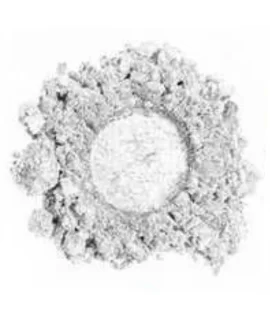SILICA GEL (white/colorless), 99%, kg
9.00 €
Silicon dioxide, CAS 112926-00-8 / 7631-86-9, silicon oxide, silicon dioxide xerogel, silicon gel, desiccant, moisture absorber for desiccators
Parameter | Feature |
Silica gel | Silica, silica xerogel, silica gel |
Formula | SiO2 |
Structure |
|
IUPAC | Silicon dioxide - Silica dioxide |
INCI | - |
CAS | 112926-00-8 / 7631-86-9 |
Clay mass | 60.08 g/mol |
Density | 0,50 g/cm3 |
Solubility | Insoluble in water, it absorbs large amounts of water, up to 50% of its mass. |
Silica gel is an amorphous and porous form of silica (silicon dioxide), consisting of an irregular three-dimensional structure made up of alternating silicon and oxygen atoms, with nanometre-sized voids and pores. Silicon xerogel, with an average pore size of 2,4 nanometres, has a high affinity for water molecules and is widely used as a desiccant. It is hard and translucent, but considerably softer than solid quartz glass or quartz, and remains hard when saturated with water.
In the home, silica gel is used to protect expensive leather goods such as jackets, shoes, handbags, etc. It absorbs moisture from shoes - after a workout, after rain, in winter - to preserve footwear and prevent bad foot odour. If you already have bacteria that cause bad foot odour, using silica gel can reduce their impact and eventually, without the right environment to live in, they naturally disappear and the foot odour becomes normal. When used on bookshelves, silica gel prevents books from developing unpleasant odours and eliminates the smell of old books;
In metalworking, silica gel is used to protect metals against corrosion by eliminating one of the factors that cause corrosion (moisture). It thus protects ferrous metals, steel and iron from rusting; it is very widely used with plant parts, industrial - manufacturing equipment or military instruments to keep metals intact from corrosion or oxidation processes. In the process of preservation of machinery, silica gel protects idle engines and automotive parts from rusting. For non-ferrous and precious metals, it protects them from oxidation, so that silver jewellery and tools do not lose their lustre or tarnish. The same applies to other metals.
In laboratories, silica gel is used in desiccators (desiccators) to protect dry materials from the effects of ambient humidity after heating. In many cases, freshly regenerated silica gel or a mixture with an indicator silica gel (which changes colour depending on moisture content) is used.
In perfumery, silica gel is used to stabilise fragrances and to produce air fresheners. Silica gel absorbs fragrances into itself when they are wetted/sprayed on, and remains in the environment for a long time after use. Due to its adsorptive properties, silica gel helps the air fresheners to last longer, unlike paper air receivers. Its transparent spherical structure gives a good visual appearance and eliminates the need for additional filler.
In electrical engineering, silica gel is used both to protect electrical equipment from moisture during storage, to remove moisture from wet electronics (e.g. wet mobile phones) and to dry the air around large electrical equipment.
In floristry, silica gel is used to dry flowers without damaging the flower. It is reusable, so it is recommended to activate it before use by using a microwave oven for 2-3 minutes in the defrost mode or by using an oven to heat the silica gel at 200-2500C for 20-40 minutes. The most commonly recommended use is to fill the bottom of the box with silica gel, place the desired flowers or blossoms with 2-5cm space between them and carefully fill the remaining volume with silica gel and close the box tightly. Once the flowers have dried, carefully remove them and shake off the silica gel spheres. As they are 2-5 mm in size, it is convenient as there is no need to clean them with a brush. The drying time of the flowers is very individual, depending on the size of the flower and the temperature. Normally a rose flower dries in 2 days in summer and 5 days in winter.
In construction, silica gel is used in old-style double wooden windows, where it is placed in the space between them for the winter, thus removing moisture and preventing dew from forming in the window space. On the other hand, the windows last considerably longer. After the winter season, it is recommended to activate (dry) the silica gel in a microwave or oven.
In industry, silica gel is always used in the transport of goods, where items are packed with silica gel bags. Silica gel is also used in freight trailers and shipping containers to protect the goods from moisture damage. Silica gel is also used in industrial compressed air systems for air drying. The compressor's discharge air flows through a load of silica gel beads where it adsorbs moisture from the air, so that the compressed air is not damaged by condensation or moisture. The same system is used for drying compressed air in railway locomotives, as condensation and ice in the brake air tubes can cause brake failure.
Important: add the product to your basket, fill in the recipient's details and confirm your order. Thank you!
To save you valuable time, we will deliver your order to your address at your convenience!
*- Photographs of the goods may not reflect the actual appearance, colour, assembly or shape of the goods and their packaging. The information in the product description is general and may not correspond to the information on the product packaging. The information given about the stocks and prices of goods may, in some cases, differ from the actual prices and stocks of goods
Signal word: Not applicable |
Hazard icons: Not applicable |
Danger phrases: Not applicable |
Precautionary statements: not applicable |
Related products
(8 other products in the same category)












